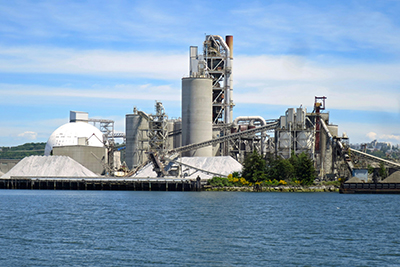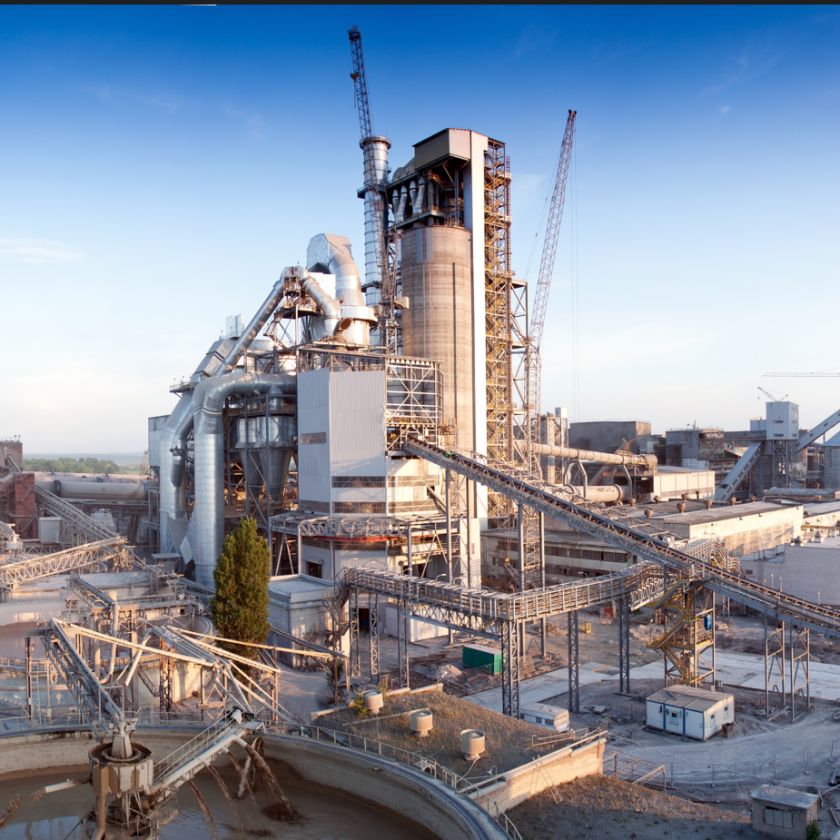Thermal Substitution Rates Up To 100% Are Technically Possible And Are Being Achieved At Some European Plants. But Not In The U.S. Cement Optimized Spoke To Rick Bohan And Sean O’neill Of The Portland Cement Association About The Current State Of Alternative Fuels And What’s Being Done To Accelerate Their Adoption.
By Jonathan Rowland
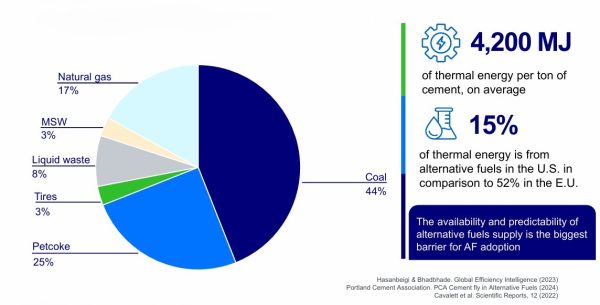
Fuel switching is essential to cement decarbonization strategy, including the U.S. roadmap published by the Portland Cement Association (PCA). Despite this, the average U.S. thermal substitution rate (TSR) is far lower than in other developed economies. The EU’s average TSR is about 52%, although considerable regional variation exists. Some plants regularly achieve an average TSR of around 80% and can peak at 100%. The average TSR in the Japanese industry hits over 50%, while it’s about 45% in the UK.
According to Rick Bohan, the PCA’s senior vice president for sustainability, the average fuel substitution rate in the United States in 2023 was 16%, a 1.4% increase from the previous year. Beneath that headline statistic, however, lies significant variety. For example, one-sixth of plants surveyed by the PCA have used over 30% of alternative fuels – such as plastics, windmill blades, crumb rubber and oily sawdust – in production. In addition, 36% of plants reported using renewable and biomass, a 12% increase from the year before.
This compares to coal and petcoke, which account for about 60% of the U.S. industry’s fuel mix. “The goal is to flip those numbers and then some,” said Bohan. “Our 2050 scenario aims for coal and petcoke to make up no more than 10% of the fuel mix while alternative fuels and biofuels account for at least 60% to 70%.”
As part of efforts to achieve this, PCA member companies have partnered with the Lawrence Berkeley National Laboratory to investigate the availability and emissions associated with non-traditional fuels for industrial decarbonization. Lawrence Livermore National Laboratory, Missouri University of Science and Technology, Sandia National Laboratory, the American Council for an Energy-Efficient Economy, and the University of California at Davis are also partners in these efforts. One outcome of the research is to produce a web-based geospatial tool that evaluates the availability of non-traditional fuels.
Policy Problems
High TSRs are technically feasible, as demonstrated in other parts of the world; the obstacles lie more on the policy side, explained Bohan. “Current legal and regulatory requirements prevent significant amounts of secondary materials and wastes being used as alternative fuels, despite the demonstrably lower greenhouse gas and other emissions produced and the community and environmental benefits associated with diverting these materials from landfills and traditional incineration.”
The PCA’s comments on the Department of Energy’s Draft Strategic Framework on Circularity for Secure and Sustainable Products and Materials reinforce this point. While agreeing with the framework’s mission, vision, and objectives to move from a linear to a circular economy, the association noted that the draft framework was “too narrow in scope” and failed to “take into account the beneficial use of secondary materials and byproducts as alternative fuels and as feedstocks for manufacturing.”
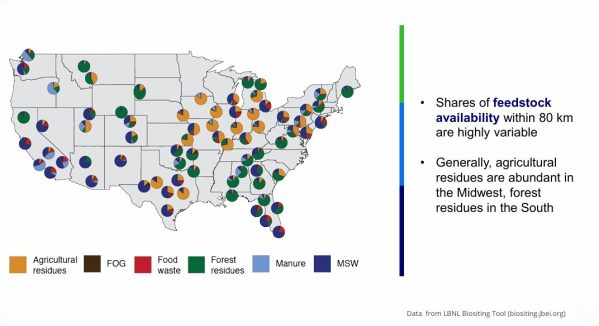
Source: Lawrence Berkeley National Lab, Dec. 2024.
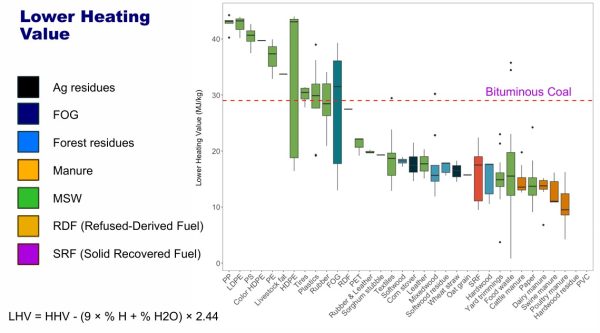
Examples of lower heating value fuels compared with bituminous coal baseline.
Source: Lawrence Berkeley National Lab, Dec. 2024.
“The Clean Air Act, Resource Conservation and Recovery Act, and the Environmental Protection Agency’s Non-Hazardous Secondary Materials Rule restrict the use of secondary materials and wastes as fuels, imposing onerous and unnecessary requirements,” said Sean O’Neill, the PCA’s senior vice president for government affairs. “If policymakers are serious about transforming from a linear to a circular economy, these laws and regulations must change and regulatory barriers removed.”
The case of cellulosic biomass offers an example of the complications posed by current regulations. The EPA recently said cellulosic biomass – including construction and demolition (C&D) wood and agricultural wastes – could be used as a fuel if managed separately from solid waste. The agency provided examples of peanut shells collected at a nut processor or yard trimmings, leaves, branches and other plant material collected separately from municipal solid waste (MSW).
Discarded or Not Discarded?
The “not discarded” categorization is critical here. In technical EPA speak, “not discarded” materials are regarded as equivalent to traditional fuels and regulated as such. In contrast, biomass that has been ‘discarded’ – or mixed with solid waste streams, be that MSW or mixed C&D debris – is considered solid waste. Plants that burn this material are considered solid waste incineration units and are subject to additional regulation under Section 129 of the Clean Air Act.
“Allowing some cellulosic biomass to be burned in the same way as traditional fuels is a move in the right direction; however, the cement industry could use significantly more types of biomass as fuel if additional guidance allowed for other biomass sources to be considered non-discarded,” said Bohan. “For example, the PCA has been involved in the Department of Energy’s Billion-Ton Project, which assesses the potential biomass resources available in the U.S.”
The latest 2023 report identified up to 1.5 billion tons of annual biomass production potential, including 161 million dry tons per year of waste resources above current uses in the near term. This rises to 217 million dry tons in the project’s mature market scenario.
“These are materials with embodied energy that can be used safely and effectively in cement production, as we see at numerous plants worldwide,” said Bohan. “More than that, cement kilns provide the ideal place to use these materials due to the high operating temperatures and long residence times, which makes them extremely efficient at combusting alternative fuels with high heating value while maintaining emissions as or below traditional fossil fuel levels.”
Further policy support should also focus on disincentivizing landfilling, particularly to limit the landfilling of non-recyclable materials with residual energy content, continued O’Neill. “The EU has taken this approach and successfully increased the beneficial use of secondary materials. Using this material as an alternative fuel has a double benefit: it displaced fossil fuels while avoiding methane – a much more potent greenhouse gas than carbon dioxide – emissions from landfills.”
The Energy Efficiency Conundrum
Promoting the use of alternative fuels has a knock-on impact in other areas. Energy efficiency is one of these, as Bohan explained. “Alternative fuels generally offer lower heating value than traditional fossil fuels. Increasing TSR, thus, reduces energy efficiency – as more fuel is burned to deliver the required energy input – which runs counter to programs like the EPA’s ENERGY STAR.”
In response, the cement industry’s ENERGY STAR Energy Performance Indicator is one of the few that asks plants to report their energy inputs in lower heating value (LHV) or physical units rather than higher heating value (HHV), a move the PCA was involved in.
“This helps demonstrate why the cement industry needs an all-of-the-above strategy when it comes to decarbonization,” continued Bohan. “Think of a cement plant like a balloon: if you squeeze one area, another part will inflate. So, too, if you change one aspect of the cement-making process, it will impact another. The key is to evaluate the whole to ensure that you’re not going to burst the balloon, and then to ensure any changes made contribute to the overall goal – which in this case is carbon reduction.”
Fuel Security
A final consideration of fuel switching is fuel security. Growing alternative fuel use in the U.S. cement industry will require the development of reliable and consistent alternative fuel supplies, both in terms of their availability and delivery and in terms of their heating value and chemical composition. Unlike the EU, where a waste management ecosystem has long been in place to process and supply cement plants, this will require investment and time to establish in the United States.
Several cement companies have also created successful waste management divisions to support their ambitions for alternative fuels (although these take time to establish). The cement industry is also not alone in wanting this. According to a 2023 study by waste management firm Veolia, 52% of U.S. businesses with revenues over $500 million have zero-waste-to-landfill goals and another 22% plan to develop such goals in the next two years.
When a reliable supply of alternative fuels is in place, it also benefits energy security. “Use of secondary materials and waste as lower-carbon alternative fuels will enable the U.S. cement industry to have more reliable and secure energy sources in the case of supply shocks, external events, or other circumstances that increase fossil fuel prices,” said O’Neill. “Alternative fuels can, thus, provide certainty to cement manufacturers and avoid disruptions if world events reduce fossil fuel supply. Additionally, domestically produced alternative fuels reduce any further reliance on fossil fuels from foreign sources.”
A Trump-Shaped Question Mark
Of course, this discussion takes place in a changed political environment with a different approach to environmental sustainability. According to O’Neill, however, the PCA and its members remain fully committed to carbon neutrality and the association’s decarbonization roadmap.
He also pointed to the Trump administration’s prioritization of domestic energy sources. “We share this concern – and would highlight that alternative fuels are as much American-made energy as natural gas. We hope the new administration will help us accelerate alternative fuel adoption through sensible and supportive regulation, and we will engage with them – as we do with all administrations – to achieve that.”

